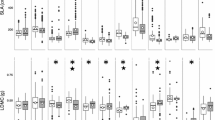Abstract
When studying how a community responds to its environment, it is typically the case that different taxa will respond in different ways. An important challenge for the ecologist is to go deeper (Shipley, From plant traits to vegetation structure: chance and selection in the assembly of ecological communities. Cambridge University Press, 2010; McGill et al., Trends Ecol Evol 21:178–185, 2006), to look for patterns in environmental responses, and, where possible, to capture the mechanisms by which taxa vary in their environmental response (as in Exercise 16.1). What are the main types of response to environmental gradients? Why do taxa differ in their environmental response?
Access this chapter
Tax calculation will be finalised at checkout
Purchases are for personal use only
Similar content being viewed by others
Notes
- 1.
Although technically they are actually related, a mixture model is a type of mixed model where the random effect is not normally distributed; instead it has a multinomial distribution that takes G different values.
References
Brown, A. M., Warton, D. I., Andrew, N. R., Binns, M., Cassis, G., & Gibb, H. (2014). The fourth-corner solution—using predictive models to understand how species traits interact with the environment. Methods in Ecology and Evolution, 5, 344–352.
Dunstan, P. K., Foster, S. D., & Darnell, R. (2011). Model based grouping of species across environmental gradients. Ecological Modelling, 222, 955–963.
Foster, S. D., Hill, N. A., & Lyons, M. (2017). Ecological grouping of survey sites when sampling artefacts are present. Journal of the Royal Statistical Society: Series C (Applied Statistics), 66, 1031–1047.
Hui, F. K. C. (2016). boral—Bayesian ordination and regression analysis of multivariate abundance data in R. Methods in Ecology and Evolution, 7, 744–750.
Hui, F. K. C., Warton, D. I., Foster, S., & Dunstan, P. (2013). To mix or not to mix: Comparing the predictive performance of mixture models versus separate species distribution models. Ecology, 94, 1913–1919.
Jamil, T., Ozinga, W. A., Kleyer, M., & ter Braak, C. J. F. (2013). Selecting traits that explain species–environment relationships: A generalized linear mixed model approach. Journal of Vegetation Science, 24, 988–1000.
Keribin, C. (2000). Consistent estimation of the order of mixture models. Sankhyā: The Indian Journal of Statistics, Series A, 62, 49–66.
Lance, G. N., & Williams, W. T. (1967). A general theory of classificatory sorting strategies: 1. Hierarchical systems. The Computer Journal, 9, 373–380.
Legendre, P., Galzin, R., & Harmelin-Vivien, M. L. (1997). Relating behavior to habitat: Solutions to the fourth-corner problem. Ecology, 78, 547–562.
McGill, B. J., Enquist, B. J., Weiher, E., & Westoby, M. (2006). Rebuilding community ecology from functional traits. Trends in Ecology and Evolution, 21, 178–185.
McLachlan, G., & Peel, D. (2000). Finite mixture models. Wiley.
Niku, J., Hui, F. K. C., Taskinen, S., & Warton, D. I. (2019). gllvm: Fast analysis of multivariate abundance data with generalized linear latent variable models in R. Methods in Ecology and Evolution, 10, 2173–2182.
Ovaskainen, O., & Abrego, N. (2020). Joint species distribution modelling: With applications in R. Cambridge: Cambridge University Press.
Ovaskainen, O., Tikhonov, G., Norberg, A., Guillaume Blanchet, F., Duan, L., Dunson, D., Roslin, T., & Abrego, N. (2017b). How to make more out of community data? A conceptual framework and its implementation as models and software. Ecology Letters, 20, 561–576.
Pledger, S. (2000). Unified maximum likelihood estimates for closed capture–recapture models using mixtures. Biometrics, 56, 434–442.
Pledger, S., & Arnold, R. (2014). Multivariate methods using mixtures: Correspondence analysis, scaling and pattern-detection. Computational Statistics & Data Analysis, 71, 241–261.
Pollock, L. J., Morris, W. K., & Vesk, P. A. (2012). The role of functional traits in species distributions revealed through a hierarchical model. Ecography, 35, 716–725.
Shipley, B. (2010). From plant traits to vegetation structure: Chance and selection in the assembly of ecological communities. Cambridge University Press.
Shipley, B., Vile, D., & Garnier, E. (2006). From plant traits to plant communities: A statistical mechanistic approach to biodiversity. Science, 314, 812–814.
ter Braak, C. J. F. (2017). Fourth-corner correlation is a score test statistic in a log-linear trait–environment model that is useful in permutation testing. Environmental and Ecological Statistics, 24, 219–242.
Wang, Y., Naumann, U., Wright, S. T., & Warton, D. I. (2012). mvabund—an R package for model-based analysis of multivariate abundance data. Methods in Ecology and Evolution, 3, 471–474.
Warton, D. I., Shipley, B., & Hastie, T. (2015). CATS regression—a model-based approach to studying trait-based community assembly. Methods in Ecology and Evolution, 6, 389–398.
Welsh, A. H., Cunningham, R. B., Donnelly, C. F., & Lindenmeyer, D. B. (1996). Modelling the abundance of rare species: Statistical methods for counts with extra zeros. Ecological Modelling, 88, 297–308.
Williams, W., & Lambert, J. T. (1966). Multivariate methods in plant ecology: V. Similarity analyses and information-analysis. The Journal of Ecology, 54, 427–445.
Author information
Authors and Affiliations
Rights and permissions
Copyright information
© 2022 The Editor(s) (if applicable) and The Author(s), under exclusive license to Springer Nature Switzerland AG
About this chapter
Cite this chapter
Warton, D.I. (2022). Understanding Variation in Environmental Response Across Taxa. In: Eco-Stats: Data Analysis in Ecology. Methods in Statistical Ecology. Springer, Cham. https://doi.org/10.1007/978-3-030-88443-7_16
Download citation
DOI: https://doi.org/10.1007/978-3-030-88443-7_16
Published:
Publisher Name: Springer, Cham
Print ISBN: 978-3-030-88442-0
Online ISBN: 978-3-030-88443-7
eBook Packages: Mathematics and StatisticsMathematics and Statistics (R0)




